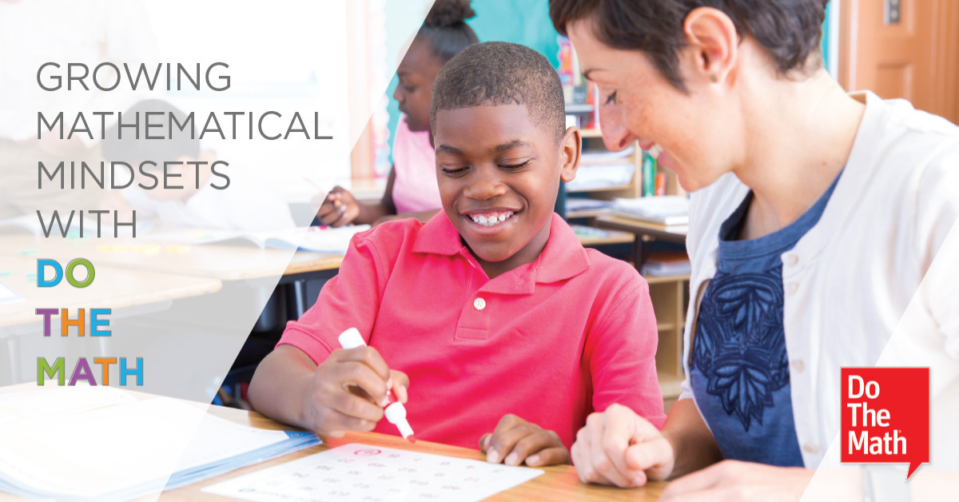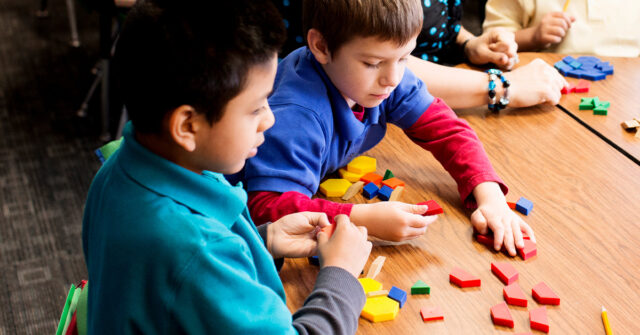
I am a capable math learner.
I am a person who enjoys mathematical thinking.
I am a mathematician!
We want each of our students to hold these beliefs, to have a robust identity as a mathematician. Renowned math educator leader Jo Boaler tells us that students possess a mathematical mindset when they “see mathematics as an open, growth, learning subject and themselves as powerful agents in the learning process.” Boaler and other respected researchers have provided us with hard evidence that students’ mindsets play an important role in their learning success (Boaler, 2016; Duckworth, 2016; Hattie, Fisher, & Frey, 2017; Saphier, 2017). Struggling math students are often doubly disadvantaged by gaps in conceptual understanding that prevent access to their grade-level mathematics curriculum and their own mindsets towards mathematics learning.
Do The Math, a powerful supplemental math program that can be used for intervention or to supplement core instruction in numerical reasoning created by Marilyn Burns and a team of master educators, is designed to build or rebuild students’ mathematical foundations as well as their relationship with mathematics. What features of Do The Math promote mathematical mindsets? How can we maximize the impact of Do The Math on students’ habits of mathematical thinking and their confidence as mathematicians?
How does the design of Do The Math build mathematical mindsets?
- Do The Math teaches for understanding and sense making. When students begin to see the patterns and structures of mathematics they gain access to the rich and exciting world of mathematical thinking. They are empowered to tackle new and challenging problems, creating an upward spiral of continued eagerness to be stretched as learners and mathematical thinkers.
- Do The Math scaffolds learning into bite-sized pieces that lead to deep understanding of big mathematical ideas. This scaffolding helps students experience repeated success so they begin to see themselves as capable of learning mathematics. This learning progression helps students view learning as a series of small attainable steps towards a bigger goal. Do The Math is designed from a strengths-based rather than a deficit-based model of learning, with an emphasis on helping students to build new understandings on a foundation of what is already known.
- Do The Math helps students make connections across mathematical ideas. As students experience the power of making connections, they acquire the habit of seeking connections and become active agents in their own learning. Connections help move learning into long-term memory, setting students up to access and apply their learning in future contexts.
- Do The Math strategically introduces mathematical tools to students and prepares students to use these tools. Mathematical tools are learning supports that can be used to record, communicate, and advance mathematical thinking. The use of tools also builds mental models for mathematical ideas which will serve as a foundation for future mathematics learning. When students possess a mathematical toolkit and the ability to use their tools flexibly, efficiently, and appropriately they are well equipped for mathematics success.
- Do The Math builds students’ proficiency in articulating their mathematical thinking and listening to others’ ideas. When students communicate their mathematical thinking, their learning becomes concrete and visible. When they listen to peers’ explanation and conjectures, they acquire new lenses on their own learning and come to see others as learning resources. Math talk promotes deeper reasoning, boosts retention, builds language skills, and supports social skills, all of which strengthen students’ confidence as learners.
What else can we do to strengthen our students’ mathematical mindsets?
- We can help students develop a personal definition of mathematics that goes beyond quick recall of facts and accuracy in computation. Yes, we want students to be able to compute accurately and efficiently, but these abilities represent a limited view of what mathematics is and why it is important. Mathematics is the science of patterns and structure. It involves reasoning, justifying, making connections, representing, communicating, and – yes – problem solving (the very reason for mathematics). By its very nature, mathematics is engaging, joyful, and awe-inspiring! Talk with your students about your own experiences of curiosity and fun with mathematics. Share ways that you and others use mathematics to solve real-world problems. If your own learning experiences with mathematics didn’t include opportunities to see the beauty and utility of mathematics, find ways to rebuild your relationship with mathematics as you create these experiences for students.
- We can help students strengthen their identities as math learners and mathematicians. Our identities determine our willingness to take risks in learning, the ways we frame mistakes, and our willingness to persevere in the face of challenge. It makes sense, therefore, for teachers to invest in mentoring and monitoring students’ math identities. Teach students about the habits of mathematical thinking as defined in the Standards for Mathematical Practice or your own state’s mathematical process standards. Help students learn to set goals and develop personal plans to strengthen these dispositions and habits.
- We can choose to believe that each student is fully capable of high levels of mathematical thinking and learning. Brain research offers convincing evidence that we can’t truly predict what any human being is capable of learning. Yet most of us are guilty, at least at times, of assuming there are limits to an individual student’s capacity for mathematics achievement. When we operate from this belief, we limit our ability to help students see the innate logic in mathematical ideas and our own opportunity to grow as teachers. How might we set out to disprove the idea that some students are not capable of mathematical understanding? What must we say and do to demonstrate our belief in each student’s capacity for high levels of mathematical thinking?
- We can take an honest look at our own mathematical mindsets. We can’t effectively grow mathematical mindsets in our students without first giving attention to our own mindset. Our mindset towards mathematics shapes our design of instructional tasks, our facilitation of classroom discourse, our questioning, response to mistakes, and assessment practices. In other words, it impacts the learning opportunities we provide to students. Expectations for teaching and learning mathematics are vastly different today than they were when most of us were students. We need to invest in rebuilding our relationships with mathematics, our identities as math learners, and our beliefs about the human capacity to understand mathematical ideas. It starts with each of us, but we also need to work together towards this goal.
Marilyn Burns’ vision of teachers and students who share a sense of confidence about their capacity for mathematical understanding and enjoy engaging in mathematical thinking led to the creation of Do The Math. This vision continues to guide the education community in its efforts to strengthen mathematics teaching and learning. Marilyn offers us all these words of advice and inspiration: “Let’s bring our collective intelligence to the wonder of mathematics and make some progress together…. We need to change how we think about and relate to mathematics. Our children deserve nothing less.” (Burns, 1998).
 Sue Chapman, along with colleague Mary Mitchell, are authors of MathVentures: 33 Teacher-Coach Investigations to Grow Students as Mathematicians. Sue is a Heinemann professional learning consultant and an adjunct instructor at the University of Houston – Clear Lake. You can follow Sue on Twitter at @SueChapmanLearn and at SueChapmanLearning.com.
Sue Chapman, along with colleague Mary Mitchell, are authors of MathVentures: 33 Teacher-Coach Investigations to Grow Students as Mathematicians. Sue is a Heinemann professional learning consultant and an adjunct instructor at the University of Houston – Clear Lake. You can follow Sue on Twitter at @SueChapmanLearn and at SueChapmanLearning.com.
References:
Boaler, J. (2016). Mathematical mindsets: Unleashing students’ potential through creative math, inspiring messages and innovative teaching. San Francisco, CA: Jossey-Bass.
Burns, M. (1998). Math: Facing an American phobia. Sausalito, CA: Math Solutions.
Duckworth, A. (2016). Grit: The power of passion and perseverance. New York: Scribner.
Hattie, J., Fisher, D., & Frey, N. (2017). Visible learning for mathematics: What works best to optimize student learning. Thousand Oaks, CA: Corwin.
Saphier, J. (2017). High expectations teaching: How we persuade students to believe and act on “smart is something you can get.” Thousand Oaks, CA: Corwin.


